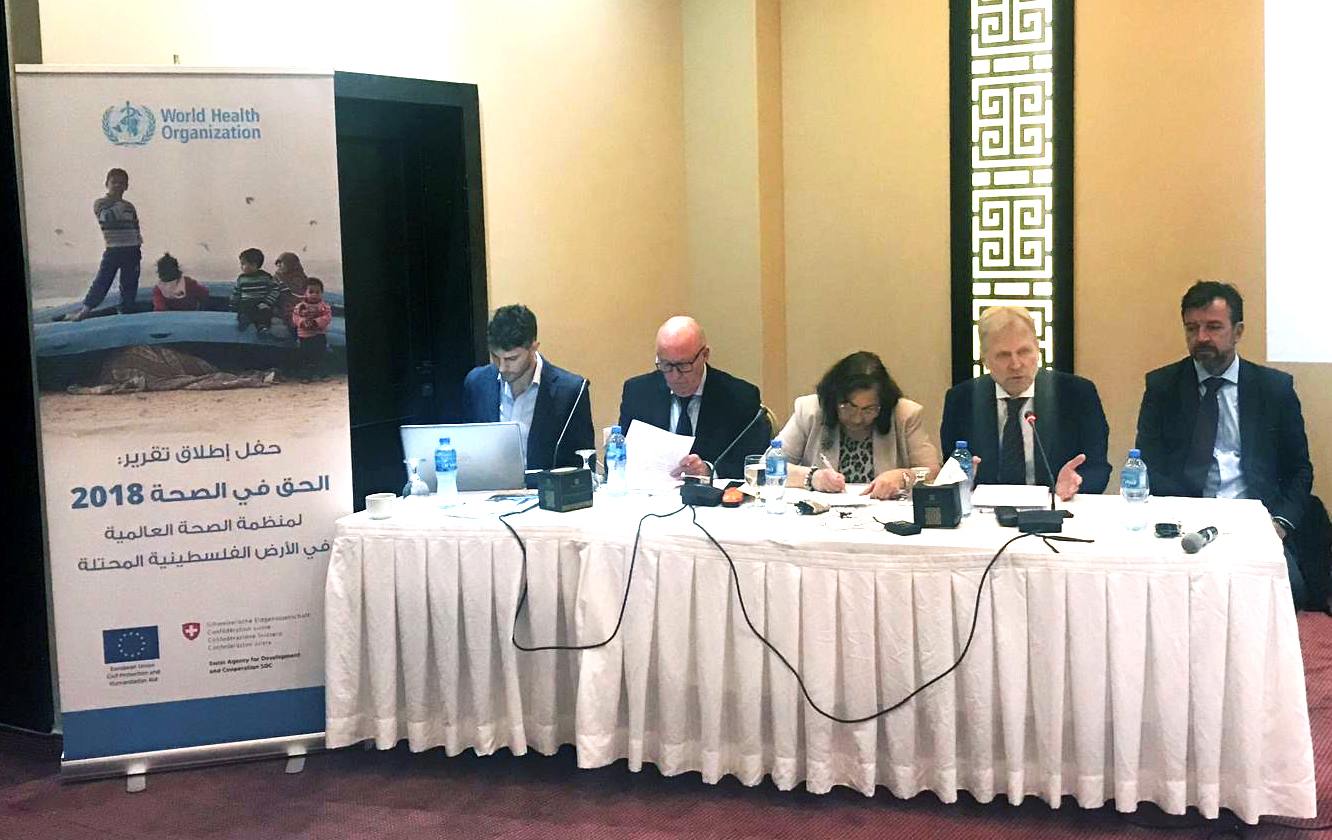 October 2019, Ramallah – WHO today released its report, “Right to Health in the occupied Palestinian territory: 2018”. The report examines obstacles to achieving the highest attainable standard of health for Palestinians living under occupation, including barriers to adequate health care provision, access to health care, determinants of health beyond health care and health attacks.
October 2019, Ramallah – WHO today released its report, “Right to Health in the occupied Palestinian territory: 2018”. The report examines obstacles to achieving the highest attainable standard of health for Palestinians living under occupation, including barriers to adequate health care provision, access to health care, determinants of health beyond health care and health attacks.
The launch event was held in Ramallah, with opening remarks from Dr Gerald Rockenschaub, Head of WHO office in the occupied Palestinian territory, Mr James Heenan, Head of the Office of the High Commissioner of Human Rights in the occupied Palestinian territory, Mr Jamie McGoldrick, Humanitarian Coordinator for the Occupied Palestinian Territory, and Dr Mai Alkaila, Minister of Health for Palestine.
Dr Rockenschaub commented on the findings of the report: “Palestinians in the West Bank and Gaza Strip continue to face major barriers to the realization of the right to health. Sustainability of quality health care services is challenged by chronic occupation and fragmentation; restrictions on movement have a profound impact on access to health care, including for some of the most vulnerable Palestinian patients. A study completed by WHO this year demonstrates that cancer patients initially denied or delayed permits to access chemotherapy and/or radiotherapy outside Gaza from 2015 to 2017 were 1.5 times less likely to survive in the following six months or more, compared to those initially approved permits. The findings highlight the urgent need for reform to remove access barriers to protect patients from harm.”
Palestinians living under Israeli occupation in the West Bank and Gaza Strip are exposed to high levels of violence. In 2018, 299 Palestinians were killed and 31,723 injured in occupation-related violence, of which the vast majority (87% of deaths and 81% of injuries) occurred in the Gaza Strip in the context of the Great March of Return, which began on 30 March 2018. The public health consequences of violence are severe. Over a half of conflict-affected children may be affected by post-traumatic stress disorder, while the long-term consequences of injuries, with more than 6,000 live ammunition injuries in Gaza alone over the year, put strain on an already overburdened health system. Health staff, too, work at considerable personal risk. In 2018, there were an unprecedented 432 attacks against health care in the West Bank and Gaza Strip. In Gaza alone, three health workers were killed and 570 injured, 41 with live ammunition, while providing care to those injured in Gaza’s Great March of Return.
Zeiad, a first responder with the Palestinian Red Crescent Society (PRCS), was injured with live ammunition at one of the peak times of the demonstrations when there was a huge volume of injuries overwhelming the public hospitals in Gaza. He was taken in a critical condition to the PRCS hospital for emergency surgery. Zeiad stated, “When I remember the events of that day, it makes me very sad. Even us health workers – carrying out our humanitarian work and clearly marked with our PRCS vests – were targeted with live ammunition.”
Mr McGoldrick discussed the humanitarian situation for Palestinians: “The dire humanitarian situation – particularly in the Gaza Strip and for West Bank communities in Area C, East Jerusalem and H2 area of Hebron – has profound implications for people’s health. WHO’s report highlights the health implications of impediments to inadequate access to water and sanitation, high rates poverty, unemployment and food insecurity and insecure housing, demolitions and displacement.”
He expressed concern about ongoing high levels of exposure to violence, including for health workers: “No patient should have to worry about being prevented from accessing essential and lifesaving treatments, whether access to health facilities requiring Israeli-issued permits or access to essential medicines within Palestinian health facilities. No health worker should have to go to work with the fear of being shot at and killed. WHO’s report underlines the immediate need for our collective efforts to strengthen the protection of health care.”
The full report can be found here: Right to health 2018


